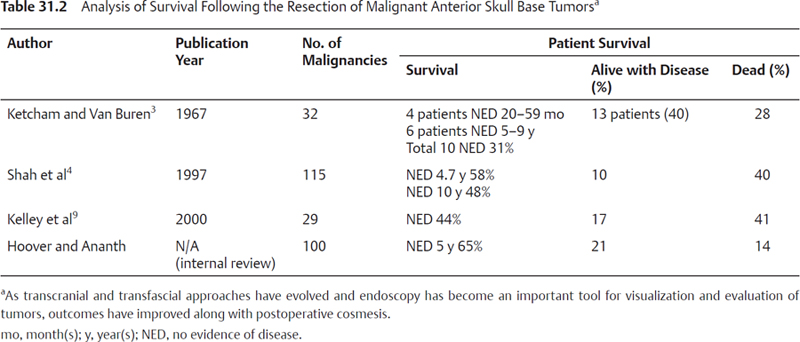31 Endoscopic and Endoscopic-Assisted Anterior Skull Base Surgery for Malignancy: Surgical Considerations Anterior skull base malignancies are a challenging problem because of the complex anatomy, vital adjacent and often involved structures, and many skull base fissures and foramina that transmit vessels and nerves and may allow central extension. Until 1960s there were only sporadic cases of transfascial resection of anterior skull base tumors in the United States,1 and in Germany, by Schloffer (1906) and Hirsch (1910) were reported.2 Too often these tumors were incompletely excised by isolated attempts from either below or above. Extensive lesions in this area generally require the combined skills of a team of specialists, including otolaryngology/head and neck/skull base surgeons and neurosurgeons, to successfully resect lesions that extend both intra- and extracranially. Ketcham in 1963, and then subsequently in 1967, first described the combined transcranial and transfascial approach to these tumors.3 Since then, the technologic developments of computed tomography (CT) and magnetic resonance image (MRI) scanning have significantly improved our ability to evaluate the extent of these tumors and plan surgical approaches preoperatively. When such imaging indicates a tumor is highly vascular, angiographic techniques allow embolization to markedly reduce operative bleeding and enhance tumor visualization. Modern operating room guidance systems allow visual display fusion of preoperative CT, MRI, and magnetic resonance angiography that greatly assists in complete resection with avoidance of excess bleeding.4 Table 31.1 Various Malignant Tumors Resected in Our Study Populationa
Histologic Tumor Type | Patient Numbers |
Squamous cell carcinoma | 29 |
Esthesioneuroblastoma | 26 |
Adenoid cystic carcinoma | 14 |
Sarcoma | 7 |
Adenocarcinoma | 3 |
Lymphoma | 3 |
Melanoma | 3 |
Nasopharyngeal carcinoma | 3 |
Sinonasal undifferentiated carcinoma | 3 |
Small cell neuroendocrine carcinoma | 3 |
Ameloblastoma | 1 |
Hemangiopericytoma | 1 |
Meningioma | 1 |
Metastatic renal cell carcinoma | 1 |
Mucoepidermoid carcinoma | 1 |
Neuroblastoma, child | 1 |
Total | 100 |
At our institution, we have organized a skull base surgical team consisting of the previously mentioned surgical specialties, and such a team is highly recommended at any institution performing this type of surgery. We frequently use the services of radiation and medical oncologists who understand our goals and treatment plan. We previously described the importance of the use of endoscopes during these resections and will discuss this use later on in this chapter.3–5 In this chapter, we will explore important general considerations in the multidisciplinary approach, techniques, and rationale for endoscopic and endoscopic-assisted anterior cranial base surgery.
General Considerations and Institutional Experience
As a backdrop to this discussion, the authors reviewed the experience of the senior author (L.A.H.). During a 21-year time period, the senior author has treated 208 patients with anterior skull base lesions. Of the 208 patients who underwent anterior skull base tumor resection, 100 had sufficient information and follow-up at 5 years to be included in this review. Outcomes were separated into no evidence of disease, active disease, or death. Of the 100 patients included in this analysis, there were 63 (63%) males and 37 (37%) females, with a mean age of 56 years (standard deviation, 17 years). Presentation most commonly included a history of nasal obstruction, sinusitis, or unilateral epistaxis. Resected tumors included three main types: squamous cell carcinoma (29), adenoid cystic carcinoma (14), and esthesioneuroblastoma (26). The other histologic tumor types are shown in Table 31.1. When overall results of this patient group are compared with published reports in the literature, they compare favorably (Table 31.2). The technical considerations in this chapter reflect the experience in treating these patients.
Surgical Planning and Technology
Several technological advancements and tools assist in the execution of endoscopic and endoscopic-assisted surgery, and these are reviewed in detail in other chapters. However, it is important to realize how much technology has enabled the use of minimally invasive methods. The use of preoperative imaging with preoperative endoscopic examination is indispensable to planning and intraoperative execution (Fig. 31.1
Stay updated, free articles. Join our Telegram channel

Full access? Get Clinical Tree



